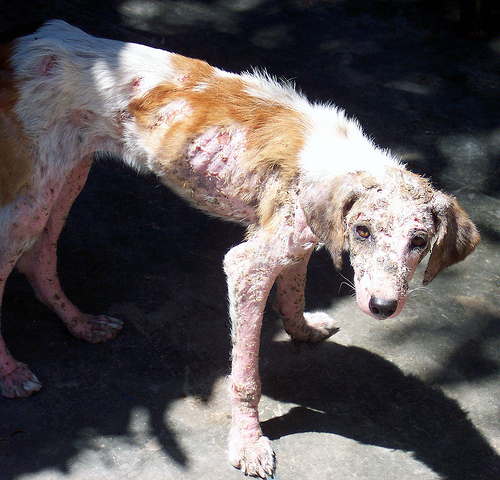
(Demodectic mange, follicular mange, “red mange”)
Demodex mites are microscopic parasites that can be found in the hair follicles of nearly every domestic animal, from cats and dogs, to hamsters, sheep, pigs, goats and cows. While these mites rarely present a problem in most animals, in dogs (and hamsters) it is common for Demodex mites to proliferate and cause serious skin disease.
Are all types of mange the same?
No. Demodectic mange is caused by the mite Demodex canis. Sarcoptic mange is caused by the far more contagious mite Sarcoptes scabiei. These mites are found on different areas of the body and show different clinical signs.
How did my pet catch Demodex?
The mites are typically acquired in the first few days of life from the dam. While puppies (average 3-6 months) are probably the most likely to show signs of disease, older dogs can carry the mite asymptomatically for many years before showing any sign of disease.
If all animals carry the mite, then why don’t they all show signs of disease?
Animals that develop full-blown demodicosis are usually immunocompromised in some manner. The immunocompromised state may be due to:
• Genetic predisposition (especially in purebred dogs)
• Hormonal changes (particularly at oestrus)
• Immunosuppressive disease (e.g. hypothyroidism, hyperadrenocorticism)
• Therapy with immunosuppressive drugs (e.g. glucocorticoids such as prednisolone).
How can I recognize if my dog has a Demodex infection?
Demodex infections can be localised or generalised. Localised infections occur more frequently in younger dogs. The lesions are localised to one or several areas on the face (around the mouth or eyes), on the ears, on the limbs, or on the feet.
Generalized infections can be found all over the body. The signs of demodectic mange are:
• Patches of hair loss
• Redness of the skin
• Scale (dandruff)
• Crust (accumulation of surface debris on the skin)
• Lesions are rarely itchy
How are cases of demodicosis diagnosed?
Make an appointment with a veterinarian if your pet shows any signs of skin disease. Many different types of skin disease have a similar presentation, so it is important to get an accurate diagnosis before initiating treatment. The vet will diagnose Demodex mites based on the history, a physical exam, and deep skin scrapes of any lesions. The skin scrapes are then examined under a microscope and any mites present are identified.
How can I rid my pet of these mites?
Not all cases of Demodex require treatment. Localised demodicosis will spontaneously resolve in 90% of cases. Generalised demodicosis will also spontaneously resolve, but less frequently than localised demodicosis. Consult your veterinarian as to whether or not your dog needs treatment.
Amitraz (Mitaban) dip is the traditional treatment for ridding your pet of demodex mites. The topical treatment should be used every 5-7 weeks until all signs of skin disease have resolved and your pet’s skin scrapings are negative for mites. Some dogs may appear slightly sedated for a short period of time following treatment with amitraz.
Other less commonly utilised drugs for Demodex mites are oral ivermectin or oral milbemycin. While these drugs are very effective at treating demodicosis, they are not always licensed for that use. Furthermore, these drugs are can be toxic to certain dog breeds (e.g. collies, Shetland sheepdogs, Old English sheepdogs, and Australian shepherds) so consult a veterinarian before starting either of these treatments.
Is the disease contagious?
Fortunately demodicosis is one of the few parasitic diseases where you do not have to worry about your pet transferring the mites to other animals or yourself.
If my pet has had demodicosis, should it be bred from?
Because there does appear to be an underlying genetic basis to some Demodex infections, certain animals should not be bred from. If your puppy had an uncomplicated case of localised Demodex that spontaneously resolved, it is probably safe to breed from that animal.
However, if your puppy went on to develop generalised demodicosis, it should not be bred from, as it may have a genetic predisposition for mange.
(photo: amazoncares)